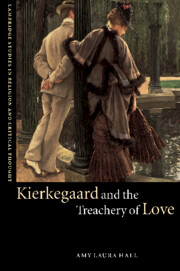Book contents
- Frontmatter
- Contents
- List of abbreviations
- Preface
- Introduction
- 1 The call to confession in Kierkegaard's Works of Love
- 2 Provoking the question: deceiving ourselves in Fear and Trembling
- 3 The poet, the vampire, and the girl in Repetition with Works of Love
- 4 The married man as master thief in Either/Or
- 5 Seclusion and disclosure in Stages on Life's Way
- 6 On the way
- Notes
- Works cited
- Index
4 - The married man as master thief in Either/Or
Published online by Cambridge University Press: 22 September 2009
- Frontmatter
- Contents
- List of abbreviations
- Preface
- Introduction
- 1 The call to confession in Kierkegaard's Works of Love
- 2 Provoking the question: deceiving ourselves in Fear and Trembling
- 3 The poet, the vampire, and the girl in Repetition with Works of Love
- 4 The married man as master thief in Either/Or
- 5 Seclusion and disclosure in Stages on Life's Way
- 6 On the way
- Notes
- Works cited
- Index
Summary
Believe me, as surely as corruption comes from man, salvation comes from woman.
(Judge William, EO, ii:207)When B supposes that out of a hundred people who go astray in the world ninety-nine are saved by women and one by divine grace, it is easy to see that he is not very good in mathematics, inasmuch as he gives no place to those who are actually lost.
(Victor Eremita, EO, i:11)DISENGAGING THE TEXT
We now enter Either/Or, that enormous book edited by the pseudonymous Victor Eremita, comprising documents by a dissatisfied sybarite (known to us as “A”), a complete scoundrel (Johannes the Seducer), a happily married man (Judge William), and a nameless Jylland pastor. Kierkegaard published Either/Or in two contrasting volumes, or parts, the first containing essays by A, closing with the exploits of Johannes, the second “containing the papers of B [Judge William], letters to A” (EO, ii:1). The dichotomous form of the text suggests that the reader's choice is as stark as the title: choose one volume or the other. It is little wonder that readers have traditionally understood Kierkegaard to be prompting a decision between two disparate realms, between the aesthetic and the ethical, between ephemeral pleasure and resolute duty. Such is the most obvious interpretation of the text.
William's treatises in Part ii overtly support this reading.
- Type
- Chapter
- Information
- Kierkegaard and the Treachery of Love , pp. 108 - 138Publisher: Cambridge University PressPrint publication year: 2002

